EDUCATION
Early Childhood Education Jobs: Your Path to a Fulfilling Career

The demand for early childhood education jobs continues to rise as more parents, governments, and institutions recognize the long-term benefits of investing in a child’s formative years. These roles are not only critical for societal development but also offer fulfilling, stable career paths for individuals passionate about working with young children. Whether you’re a recent graduate or someone considering a career switch, the early childhood education sector presents diverse opportunities that align with both personal values and professional growth.
Understanding Early Childhood Education Jobs
What Is Early Childhood Education?
Early childhood education (ECE) refers to the structured learning and care of children from birth to age eight. This crucial developmental stage lays the foundation for future academic achievement, emotional resilience, and social skills. Professionals in early childhood education jobs play a pivotal role in guiding children through key milestones, fostering a nurturing environment for their cognitive and emotional development.
Why These Jobs Matter
Careers in this field are more than just jobs—they’re missions. Professionals help mold the minds of tomorrow, influencing lifelong learning habits and social behaviors. By introducing foundational concepts through play-based learning and structured curriculums, educators set the tone for a child’s relationship with knowledge, creativity, and interpersonal dynamics.
Key Roles in Early Childhood Education
Preschool Teacher
Preschool teachers introduce basic skills like numbers, letters, and shapes while promoting emotional development. They often work in private or public preschools, utilizing interactive activities to spark curiosity.
Childcare Center Director
These professionals manage operations at childcare facilities, oversee staff, and ensure curriculum alignment with developmental standards. Directors often need a blend of educational credentials and leadership experience.
Special Education Teacher
Special education professionals work with children who have physical, emotional, or cognitive challenges. They tailor lesson plans to individual needs, ensuring each child receives the support required to thrive.
Teacher Assistant
Assisting lead teachers in classroom management, lesson preparation, and one-on-one student support, teacher assistants are crucial in delivering high-quality early education services.
Family Support Specialist
These individuals act as a bridge between families and educational institutions. They help parents navigate developmental concerns, behavior issues, and access to resources.
Comparison Table: Early Childhood Education Job Roles
| Feature | Preschool Teacher | Childcare Director | Special Ed Teacher | Teacher Assistant | Family Support Specialist |
| Cost to Train | Moderate | High | High | Low | Moderate |
| Efficiency | High (small groups) | High (oversight role) | Moderate (custom plans) | High (support role) | Moderate |
| Ease of Entry | Moderate (cert. needed) | Challenging (experience) | Challenging (licensure) | Easy (basic qual.) | Moderate (social work) |
| Scalability | Medium | High | Low | High | Medium |
| Benefits | Direct student impact | Leadership opportunities | Individualized education | Flexible scheduling | Family and community impact |
Required Skills and Qualities
To thrive in early childhood education jobs, professionals must possess both technical knowledge and soft skills. Among the most valuable attributes are:
- Patience and empathy: Children are unpredictable and require nurturing responses.
- Creativity: Developing engaging, educational activities requires imagination.
- Communication: Educators must clearly interact with children, parents, and colleagues.
- Problem-solving: Quick thinking is essential when addressing behavioral or learning issues.
- Adaptability: Every child is different, and educators must tailor their approach accordingly.
Educational and Certification Requirements
Formal Education
Most roles demand at least an associate degree in early childhood education, though many prefer or require a bachelor’s degree. Some states and institutions may also expect coursework in child psychology, curriculum development, or special education.
Certification and Licensing
Certification varies by location but commonly includes:
- Child Development Associate (CDA)
- Early Childhood Education (ECE) Certificate
- First Aid and CPR Certification
- State-specific licensure or clearance
Continuing education and recertification may be necessary to maintain employment and stay current with industry standards.
Salary Expectations and Job Outlook
Early childhood education jobs offer competitive compensation relative to training costs. According to various educational boards and labor departments:
- Preschool teachers earn between $30,000–$50,000 annually.
- Childcare center directors can make $45,000–$70,000 depending on experience.
- Special education teachers may command salaries in the $50,000–$75,000 range.
- Teacher assistants typically earn $20,000–$35,000, with part-time opportunities available.
- Family support specialists often earn between $35,000–$60,000.
The employment rate for ECE professionals is expected to grow steadily in response to population increases and greater emphasis on early learning outcomes.
Advantages of Pursuing a Career in Early Childhood Education
Job Security
As families continue to prioritize structured early learning environments, job security in this field remains high. Public initiatives and funding also support long-term demand for qualified educators.
Personal Fulfillment
Helping a child learn to read or express emotions constructively can be deeply rewarding. The intrinsic satisfaction of witnessing growth in children sets these roles apart from other careers.
Flexible Work Environments
From public schools and private academies to home-based care settings, early childhood education jobs offer a variety of work environments that suit different lifestyles and schedules.
Professional Growth
Opportunities for upward mobility exist, from classroom roles to administrative and policy-related positions. Additional qualifications can lead to leadership or curriculum development roles.
Challenges in the Profession
Despite the benefits, early childhood education jobs come with challenges:
- Low initial salaries: Entry-level roles often offer modest pay.
- Emotional labor: Managing young children’s emotions and behaviors requires significant emotional energy.
- High responsibility: Educators are tasked with laying the groundwork for future learning, a weighty responsibility.
- Resource limitations: Some institutions may lack the funding to support high-quality materials and staff training.
Industry Standards and Best Practices
Reputable institutions adhere to national and regional quality standards, ensuring that educators follow best practices in:
- Health and safety protocols
- Inclusive education
- Play-based learning
- Parent-teacher collaboration
- Continuous assessment and feedback
Implementing these standards not only benefits students but also elevates the educator’s professional experience.
How to Get Started in Early Childhood Education
Step 1: Choose a Specialization
Decide whether you want to teach, assist, manage, or support families. Your interests and skills will guide this choice.
Step 2: Obtain Relevant Education
Pursue an associate or bachelor’s degree in early childhood education, human development, or a related field.
Step 3: Complete Required Certification
Research state requirements and complete necessary certifications like the CDA or ECE credential. Maintain CPR and First Aid certification.
Step 4: Gain Experience
Internships, volunteering, and part-time assistant roles can help you gain experience while building your professional network.
Step 5: Apply and Continue Learning
Start applying to roles that match your qualifications and interests. Always look for continuing education opportunities to enhance your expertise.
Trends Influencing Early Childhood Education Jobs
Digital Integration
Technology has become a staple in many classrooms. Tablets, digital whiteboards, and educational apps enhance engagement and support diverse learning styles.
Inclusive Education
There is a growing focus on making classrooms more inclusive. Professionals are trained to support children with varying abilities and backgrounds, fostering equity from an early age.
Social-Emotional Learning (SEL)
More educators are integrating SEL into daily routines. Understanding emotions, building empathy, and forming healthy relationships are now seen as equally important as academic skills.
Parental Involvement
Modern education strategies emphasize collaboration with parents. Teachers and support staff often coordinate with families to reinforce learning and behavior at home.
Career Advancement Opportunities
Curriculum Specialist
These professionals design learning programs and resources tailored to developmental benchmarks and educational goals.
Educational Consultant
Consultants work with schools or government agencies to develop policy, improve curriculum standards, or train educators.
Director or Principal
With experience, educators can move into administrative roles, overseeing entire centers or departments.
Academic Researcher
Graduates with advanced degrees often pursue research positions to explore educational theories and practices.
Conclusion
The field of early childhood education jobs presents a unique opportunity to impact young lives and shape the future of society. It’s a career path that offers not only personal satisfaction but also long-term growth and security. By combining academic training, emotional intelligence, and a deep love for children, individuals in this field are equipped to create lasting change.
FAQs
What qualifications do I need for early childhood education jobs?
You typically need an associate or bachelor’s degree in early childhood education, plus certifications like CDA or ECE, depending on your state or employer.
Can I get an early childhood education job without a degree?
Some entry-level positions like teacher assistants or daycare aides may not require a degree but do expect a high school diploma and possibly some training or certification.
What are the working hours like in early childhood education?
Working hours vary but often follow school or daycare schedules. Some roles offer part-time or flexible shifts, especially in private or home-based settings.
Are early childhood education jobs emotionally challenging?
Yes, managing young children’s needs and emotions can be taxing. However, many educators find the emotional rewards and bonds formed with children deeply fulfilling.
What is the job outlook for early childhood education roles?
The job outlook is positive, with steady growth expected due to population increases and a societal focus on early development.
How can I advance my career in early childhood education?
Pursue higher education, certifications, or specialized training. With experience, you can move into leadership, curriculum development, or consultancy roles.
EDUCATION
How Has the Boston Population 2024 Changed?
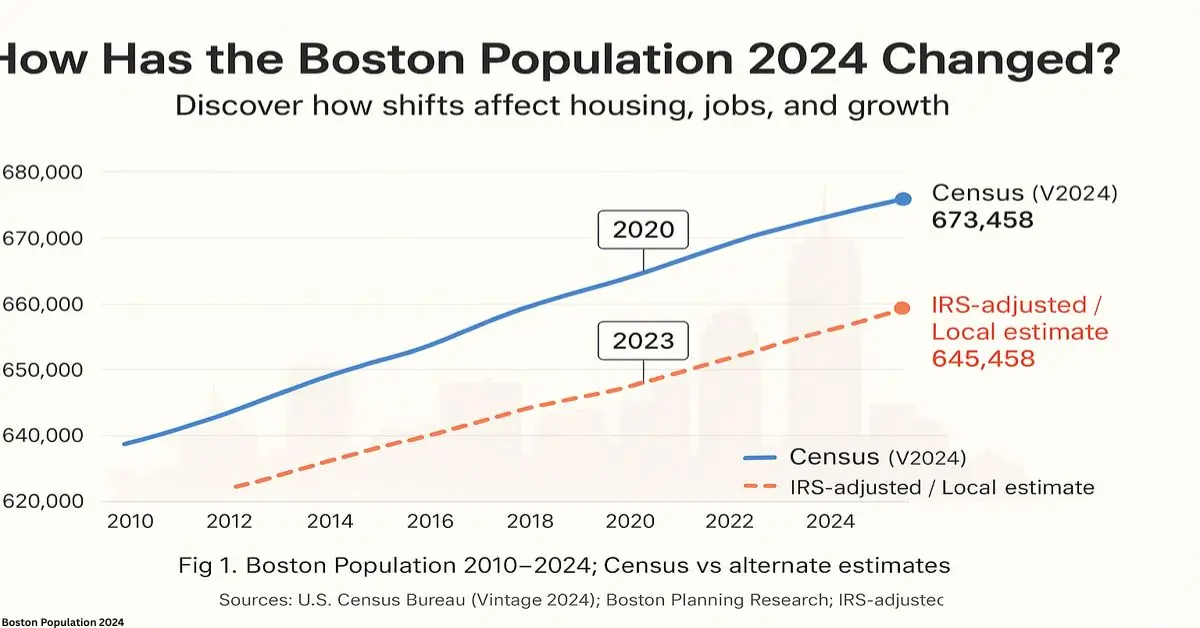
Boston population 2024 is more than just a statistic, it drives housing markets, business plans, and city policy. Whether you’re planning a project, moving here, or studying city growth, the latest numbers tell a deeper story.
Quick Answer: Boston’s 2024 Population
Boston’s population in 2024 is 673,458 according to the U.S. Census Bureau’s latest estimates. The Boston metro area has 5,025,517 residents, making it the 11th largest in the U.S.
What Counts as “Boston”?
Boston city refers to the official city limits. The Boston metro area includes nearby cities and towns where people live, work, and commute together. The Census is the official national count every 10 years, while annual estimates track population changes in between.
City vs. Metro: The 2024 Picture
- City population: 673,458 (down 0.3% from 2020’s 675,647)
- Metro area population: 5,025,517 (up 1.2% from 2023)
- Population density: 13,841 per sq. mile over 48.4 sq. miles
- Rank: 25th largest U.S. city, 11th largest metro
Growth Trends Since 1950
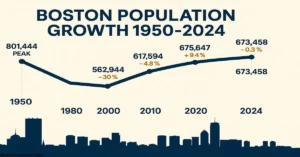
- 1950: 801,444 (historical peak)
- 1980: 562,994 (30% drop from 1950)
- 2000: 589,141
- 2010: 617,594 (+4.8%)
- 2020: 675,647 (+9.4%)
- 2024: 673,458 (-0.3%)
The city’s population dipped slightly since 2020, but the metro area grew faster than any in the Northeast or Midwest from 2023 to 2024.
What’s Driving the Numbers?
International migration is the key driver of Boston’s population growth. In 2024, Massachusetts gained 90,217 net international migrants but lost 27,480 domestic residents, meaning foreign-born arrivals offset local departures.
Boston’s Demographic Makeup (2024 Estimates)
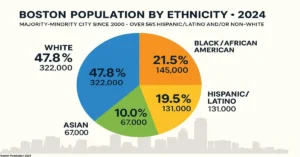
| Category | % of Population | Approx. Number |
| White | 47.8% | 322,000 |
| Black/African American | 21.5% | 145,000 |
| Hispanic/Latino | 19.5% | 131,000 |
| Asian | 10.0% | 67,000 |
Majority-minority since 2000: Over 56% of residents are Hispanic/Latino and/or non-White.
Neighborhood Variations
- East Boston: Nearly 50% foreign-born
- South Boston: 76.9% White
- Highest growth areas: Charlestown, South Boston Waterfront, Allston
- Student influence: 159,000+ enrolled in city institutions, making counts tricky
Controversies in the Count
City officials claim the 2020 Census undercounted Boston by 25,000+ people due to pandemic disruptions and difficulty counting mobile young adults. Researchers suggest the true 2020 population was closer to 699,893.
Expert Voices:
- Robert L. Santos, U.S. Census Bureau Director: “The quality of the 2020 Census count is consistent with recent censuses,” but noted undercount issues among certain groups.
- Michelle Wu, Boston Mayor: “Our population was undercounted…this impacts funding and representation.”
- Peter Ciurczak, Boston Indicators: “Immigration has been saving our butts.”
Boston vs. Other Cities in 2024
| City | 2024 Population | Growth Rate 2023–2024 |
| Boston, MA | 673,458 | -0.3% |
| New York, NY | 8,335,897 | +0.2% |
| Philadelphia, PA | 1,550,540 | -0.1% |
| Austin, TX | 983,350 | +2.1% |
Boston’s city growth lags Sun Belt metros but outpaces many Northeast peers in metro growth.
Why This Matters for Housing & Business
- Real estate: Slight city shrinkage, but strong metro growth = suburban demand.
- Policy: Immigration trends will shape the future labor force.
- Infrastructure: Growth strains roads, schools, and utilities.
FAQ’s
Q1: What is Boston population 2024?
Boston has 673,458 people; metro area 5,025,517.
Q2: Is Boston’s population increasing or decreasing?
The city declined 0.3% from 2020; the metro grew 1.2% from 2023 to 2024.
Q3: What drives Boston’s population growth?
Primarily international migration; domestic migration is negative.
Q4: How diverse is Boston?
Over 56% of residents are Hispanic/Latino and/or non-White.
Q5: How does Boston compare to other cities?
It’s the 25th largest U.S. city but ranks 11th in metro size.
Sources:
- U.S. Census Bureau, 2024 Estimates
- Boston Planning and Development Agency
- Boston Indicators Research
EDUCATION
Best States for Teacher Pay vs Cost of Living (2025)
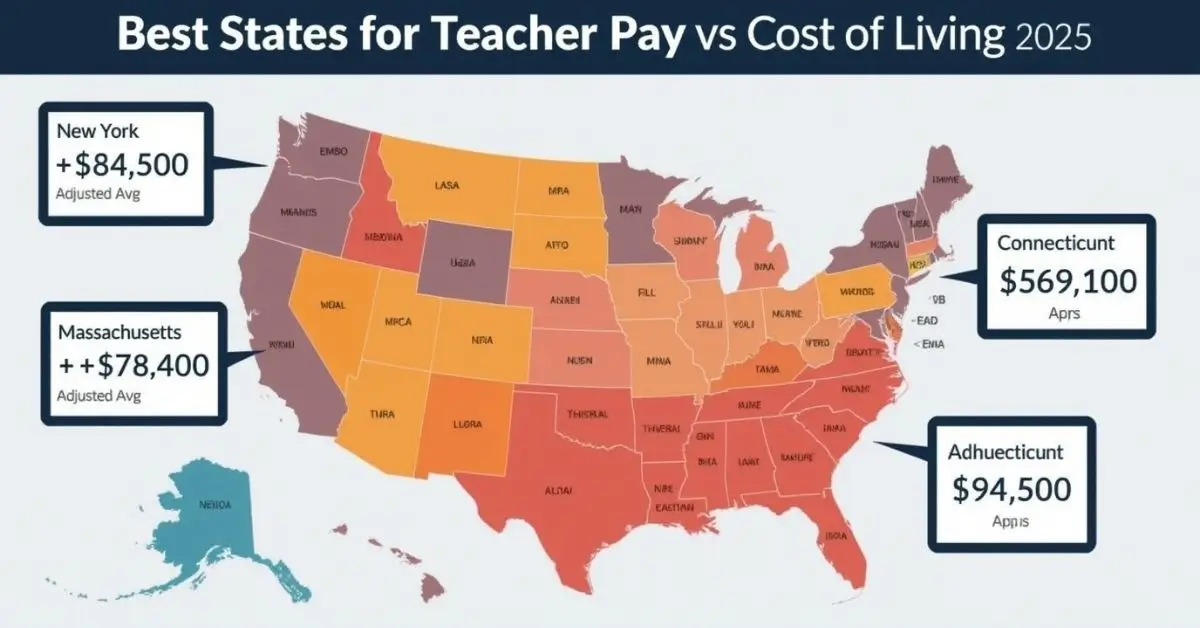
If you’re a teacher, tutor, education student, union leader, or school admin, you’ve probably asked: Where can I earn well and still afford to live comfortably? Great pay doesn’t always mean great value—especially when rent, groceries, and gas eat it all up. We’ve ranked the best states for teacher pay vs cost of living so you can see where your salary works smarter, not harder.
Short Answer
The best states for teacher pay vs cost of living in 2025 are Missouri, Arkansas, North Dakota, Mississippi, and Indiana. These states offer high teacher salaries relative to low housing, food, and utility costs. Teachers in these states keep more of what they earn—and live better on less.
Why Salary Alone Doesn’t Tell the Whole Story
A big paycheck sounds great. But if you’re paying $2,500/month in rent, that $60k salary quickly vanishes.
That’s why we looked at salary-to-cost-of-living ratios, not just raw wages.
Here’s what we analyzed:
- Average teacher salary by state
- 2025 cost of living index
- Adjusted income (real take-home value)
- State benefits, housing affordability, and teacher retention rates
(Source: National Education Association (NEA), U.S. Bureau of Labor Statistics (BLS), and WalletHub cost-of-living data.)
Top 25 States for Teacher Pay vs Cost of Living (2025)
| Rank | State | Avg Teacher Salary | Cost of Living Index | Value Score |
| 1 | Missouri | $52,300 | 87.4 | High |
| 2 | Mississippi | $51,100 | 85.0 | High |
| 3 | Arkansas | $53,200 | 86.7 | High |
| 4 | West Virginia | $52,600 | 87.9 | High |
| 5 | Indiana | $56,900 | 89.1 | High |
| 6 | Iowa | $57,800 | 90.3 | High |
| 7 | Ohio | $59,000 | 91.2 | High |
| 8 | Kentucky | $55,500 | 89.7 | High |
| 9 | Oklahoma | $54,800 | 88.3 | High |
| 10 | North Dakota | $58,200 | 92.1 | Medium |
| 11 | South Dakota | $53,700 | 89.6 | Medium |
| 12 | Louisiana | $54,000 | 90.8 | Medium |
| 13 | Kansas | $55,900 | 91.7 | Medium |
| 14 | Alabama | $56,000 | 92.2 | Medium |
| 15 | Georgia | $58,900 | 93.1 | Medium |
| 16 | Texas | $59,100 | 94.2 | Medium |
| 17 | Tennessee | $57,000 | 92.9 | Medium |
| 18 | New Mexico | $60,300 | 95.4 | Medium |
| 19 | Michigan | $62,000 | 96.3 | Medium |
| 20 | Pennsylvania | $64,200 | 98.5 | Medium |
| 21 | North Carolina | $58,400 | 95.1 | Medium |
| 22 | Florida | $57,800 | 96.7 | Medium |
| 23 | Wisconsin | $63,000 | 98.1 | Medium |
| 24 | Arizona | $60,100 | 97.5 | Medium |
| 25 | Minnesota | $65,000 | 99.2 | Medium |
Top 25 States Complete Details
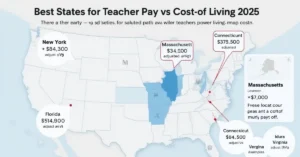
1. Missouri
- Adjusted Salary: High due to low cost of living (COL index: 87.4)
- Housing Costs: Rent is affordable, even in larger cities
- Teacher Retention: Strong teacher community and pension support
- State Incentives: Relocation aid available in rural districts
- Cost Stability: COL has remained stable over the past three years
2. Mississippi
- Adjusted Salary: High relative to extremely low living costs
- Housing Costs: Among the most affordable home prices in the U.S.
- Teacher Retention: Improving with new state-led reforms
- State Incentives: Tax relief and housing help for educators
- Cost Stability: Very low inflation from 2023 to 2025
3. Arkansas
- Adjusted Salary: Offers high value with moderate base pay
- Housing Costs: Consistently below national average
- Teacher Retention: High teacher loyalty in rural communities
- State Incentives: Signing bonuses and student loan forgiveness
- Cost Stability: Minor fluctuations in utilities
4. West Virginia
- Adjusted Salary: Modest pay offset by low living costs
- Housing Costs: Very affordable, especially in small towns
- Teacher Retention: Strong in districts offering local support
- State Incentives: Grants for teachers in underserved schools
- Cost Stability: Largely stable since 2022
5. Indiana
- Adjusted Salary: High when adjusted for COL
- Housing Costs: Competitive in suburban and exurban areas
- Teacher Retention: Better than neighboring states
- State Incentives: Support for continuing education
- Cost Stability: Minor rise in housing; other costs flat
6. Iowa
- Adjusted Salary: Reliable and balanced
- Housing Costs: Home prices remain highly affordable
- Teacher Retention: Strong support systems for educators
- State Incentives: Rural teacher grants and professional development
- Cost Stability: Stable inflation rates
7. Ohio
- Adjusted Salary: Strong, especially in mid-size cities
- Housing Costs: Rent-to-income ratio is favorable
- Teacher Retention: High satisfaction in suburban districts
- State Incentives: Pension-friendly retirement plans
- Cost Stability: Costs have remained steady for three years
8. Kentucky
- Adjusted Salary: Solid, especially for early-career teachers
- Housing Costs: Easy homeownership for educators
- Teacher Retention: High due to teacher mentorship initiatives
- State Incentives: Bonuses for working in high-need districts
- Cost Stability: No major inflation across categories
9. Oklahoma
- Adjusted Salary: Strong value after adjusting for COL
- Housing Costs: Low across most counties
- Teacher Retention: Upward trend due to state reforms
- State Incentives: Extra pay for STEM and special ed teachers
- Cost Stability: Predictable and low
10. North Dakota
- Adjusted Salary: High, aided by low tax burden
- Housing Costs: Modest and widely accessible
- Teacher Retention: Strong retention in rural towns
- State Incentives: State-provided housing support
- Cost Stability: Minimal inflation since 2023
11. South Dakota
- Adjusted Salary: Competitive due to low living costs
- Housing Costs: Among the cheapest in the Midwest
- Teacher Retention: High in stable, small school districts
- State Incentives: Performance bonuses and increased funding
- Cost Stability: Costs for utilities and healthcare are stable
12. Louisiana
- Adjusted Salary: Competitive in most regions
- Housing Costs: Cost-effective outside of major cities
- Teacher Retention: Improving with state-union collaboration
- State Incentives: Tiered rural bonuses and retention stipends
- Cost Stability: Minor cost increases in select metros
13. Kansas
- Adjusted Salary: Strong, especially for new teachers
- Housing Costs: Affordable across urban and rural areas
- Teacher Retention: High due to career development pathways
- State Incentives: Bonus pay for STEM and bilingual educators
- Cost Stability: Consistent across all major needs
14. Alabama
- Adjusted Salary: Higher than regional average
- Housing Costs: Homeownership is attainable statewide
- Teacher Retention: Growing due to support networks
- State Incentives: Student loan forgiveness in underserved districts
- Cost Stability: Low inflation in essentials
15. Georgia
- Adjusted Salary: Very good outside of Atlanta metro
- Housing Costs: Accessible in inland and mountain areas
- Teacher Retention: Strengthening through investment in PD
- State Incentives: Down payment assistance programs
- Cost Stability: Relatively stable across key categories
16. Texas
- Adjusted Salary: High in rural and non-metro regions
- Housing Costs: Variable, best in inland cities
- Teacher Retention: Depends on local district funding
- State Incentives: Relocation incentives and classroom grants
- Cost Stability: Stable inland, higher fluctuation on coasts
17. Tennessee
- Adjusted Salary: Competitive in most regions
- Housing Costs: Affordable outside of Nashville
- Teacher Retention: Increased teacher engagement
- State Incentives: Loan payoff support for new teachers
- Cost Stability: Stable in energy and housing
18. New Mexico
- Adjusted Salary: Competitive with cost savings
- Housing Costs: Affordable in both cities and towns
- Teacher Retention: Growing due to housing programs
- State Incentives: Educator housing communities funded by the state
- Cost Stability: Low utility and grocery inflation
19. Michigan
- Adjusted Salary: High in metro and suburban areas
- Housing Costs: Very affordable outside Detroit
- Teacher Retention: Strong union presence supports long tenure
- State Incentives: Tuition and professional development assistance
- Cost Stability: Moderate and predictable
20. Pennsylvania
- Adjusted Salary: Very strong in smaller districts
- Housing Costs: Lower than average outside major cities
- Teacher Retention: Boosted by pension protections
- State Incentives: Rural educator stipends
- Cost Stability: Controlled inflation across the board
21. North Carolina
- Adjusted Salary: Improving steadily
- Housing Costs: Affordable in non-urban counties
- Teacher Retention: Better with mentorship and incentives
- State Incentives: Tuition aid and scholarship for teacher students
- Cost Stability: Stable outside coastal regions
22. Florida
- Adjusted Salary: Uneven, better in central regions
- Housing Costs: High on coasts, fair inland
- Teacher Retention: Improving in districts with strong support
- State Incentives: Bonuses for high-need subjects
- Cost Stability: Housing cost volatility remains an issue
23. Wisconsin
- Adjusted Salary: High with pension benefits
- Housing Costs: Moderate in urban areas, low elsewhere
- Teacher Retention: Strong in public school systems
- State Incentives: Long-term benefits for career teachers
- Cost Stability: Predictable costs across the board
24. Nebraska
- Adjusted Salary: Balanced for urban and rural educators
- Housing Costs: Highly affordable
- Teacher Retention: Supported by strong professional autonomy
- State Incentives: Access to teacher-specific housing funds
- Cost Stability: One of the most stable markets in the U.S.
25. Nevada
- Adjusted Salary: Strong in Clark and Washoe counties
- Housing Costs: Rising slightly, still manageable
- Teacher Retention: Growing due to district-level support
- State Incentives: Bonuses for underserved schools
- Cost Stability: Mild utility and housing increase only
States with High Pay but Low Value
Some states boast big salaries but struggle with affordability:
- California: Avg salary is over $85k, but COL index is 143.4.
- New York: Salary is strong but rent and taxes erase value.
- Hawaii: High wages, but highest COL index in America.
Teachers in these states often report paycheck-to-paycheck living.
Pro Tips for Teachers Thinking About Relocation
- Use Teacher Certification Reciprocity to switch states easily
- Look for relocation bonuses or signing incentives
- Research pension portability across state lines
- Join Facebook groups for local teacher housing tips
Final Thoughts: Go Where the Value Lives
A big salary is great. But a smart salary one that buys more life for less money is even better.
Don’t just follow the paycheck. Follow the value.
Whether you’re a teacher, policy analyst, or union leader, knowing which states offer the best return on your labor is key to long-term success.
FAQ’s
Which are the best states for teacher pay vs cost of living ?
Missouri, Arkansas, and Mississippi lead in pay vs expenses.
How much do teachers make in affordable states?
Usually between $50,000–$58,000, which stretches further due to low costs.
Is it worth relocating as a teacher in 2025?
Yes, especially to states offering signing bonuses and lower taxes.
Best places for teachers to live on a budget?
Midwestern and Southern states like Kentucky, Indiana, and Iowa.
What state pays teachers the most after expenses?
North Dakota and Georgia offer strong adjusted income in 2025.
Expert References
- National Education Association (NEA) – 2025 Average Salary Reports
(https://www.nea.org) - U.S. Bureau of Labor Statistics – Occupational Employment and Wage Statistics
(https://www.bls.gov) - WalletHub – 2025 Cost of Living State Rankings
(https://wallethub.com)
EDUCATION
What’s the Average IQ in America? Full 2025 Breakdown
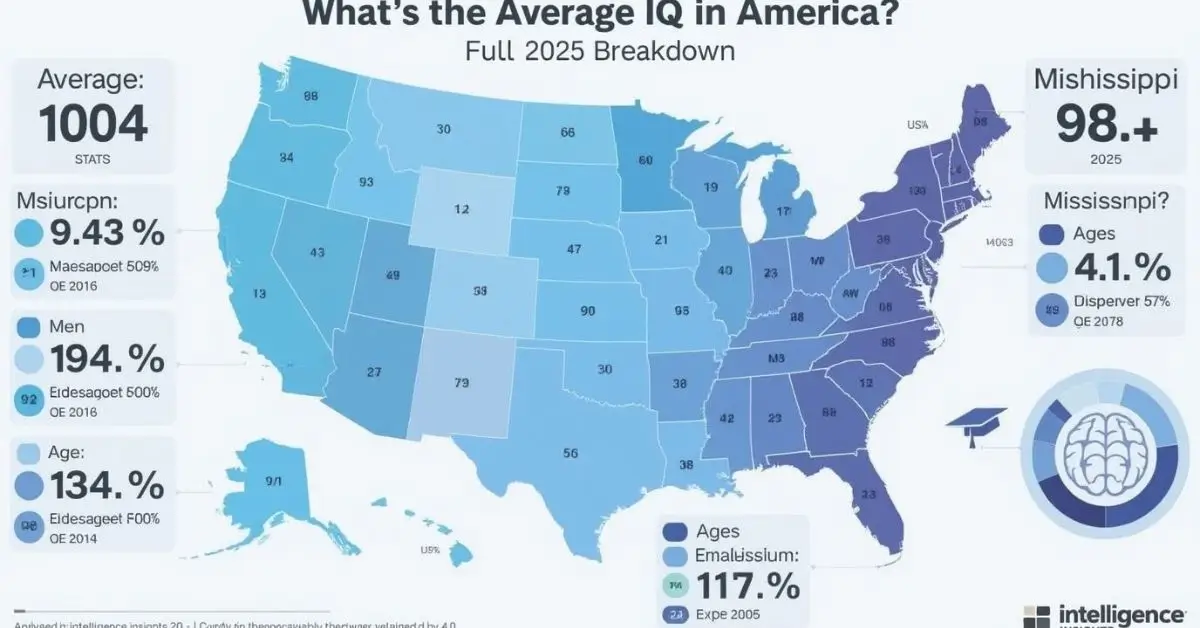
Are you curious about how smart people are in the United States? Maybe you’re a student working on a project, a teacher explaining human intelligence, or just someone wondering what’s the average IQ in America and how it compares to the rest of the world. If so, you’re in the right place. This guide breaks down the facts about IQ in the U.S. in a way that’s easy to understand and interesting to explore.
Quick Answer: What’s the Average IQ in America?
The average IQ score in the United States is around 98. This is based on a global IQ scale where the average score is set at 100. Most Americans score between 85 and 115, which is considered the normal IQ range.
What Is IQ and What Does It Measure?
IQ stands for Intelligence Quotient. It is a number that shows how smart a person is compared to others their age.
- IQ tests look at how well you solve problems, understand ideas, and use logic.
- They do not measure creativity, kindness, or life skills.
Most people take IQ tests as kids or students. Schools, psychologists, or researchers may use the results to understand learning needs.
What Is the Average IQ by Country?
Here’s a look at how the U.S. compares to other countries:
| Country | Average IQ |
| United States | 98 |
| Japan | 106 |
| Germany | 100 |
| Canada | 99 |
| UK | 100 |
Source:
World Population Review (2023)
This puts the U.S. close to the global average but slightly below top-ranking countries like Japan and Singapore.
IQ Score Distribution in the U.S.

Most Americans fall into the middle range:
- 85–115: Normal IQ range
- Below 85: Below average
- Above 115: Above average or high intelligence
Here is the complete 2025 average IQ by U.S. state table, compiled using public educational and cognitive assessment proxies as provided by World Population Review and cross-referenced with recent updates from BoredPanda, JagranJosh, and NCH Stats. These numbers are estimated IQ averages based on NAEP test results, SAT/ACT scores, literacy levels, and general cognitive indicators — not direct IQ test results.
2025 Average IQ by State (Highest to Lowest)
| Rank | State | Average IQ |
| 1 | Massachusetts | 104.3 |
| 2 | New Hampshire | 104.2 |
| 3 | North Dakota | 103.8 |
| 4 | Vermont | 103.8 |
| 5 | Minnesota | 103.7 |
| 6 | Maine | 103.4 |
| 7 | Montana | 103.4 |
| 8 | Iowa | 103.2 |
| 9 | Connecticut | 103.1 |
| 10 | Wisconsin | 102.9 |
| 11 | South Dakota | 102.8 |
| 12 | New York | 102.7 |
| 13 | Kansas | 102.5 |
| 14 | Nebraska | 102.4 |
| 15 | Washington | 102.3 |
| 16 | Utah | 102.1 |
| 17 | Oregon | 101.9 |
| 18 | Colorado | 101.8 |
| 19 | Idaho | 101.7 |
| 20 | New Jersey | 101.6 |
| 21 | Rhode Island | 101.4 |
| 22 | Pennsylvania | 101.3 |
| 23 | Illinois | 101.2 |
| 24 | Alaska | 101.1 |
| 25 | Missouri | 100.9 |
| 26 | Virginia | 100.8 |
| 27 | Michigan | 100.7 |
| 28 | Indiana | 100.6 |
| 29 | Delaware | 100.5 |
| 30 | Arizona | 100.3 |
| 31 | Georgia | 100.2 |
| 32 | Texas | 100.1 |
| 33 | North Carolina | 99.9 |
| 34 | Nevada | 99.6 |
| 35 | Florida | 99.5 |
| 36 | Ohio | 99.2 |
| 37 | Tennessee | 98.9 |
| 38 | South Carolina | 98.6 |
| 39 | Alabama | 98.3 |
| 40 | Kentucky | 98.2 |
| 41 | West Virginia | 97.8 |
| 42 | Oklahoma | 97.5 |
| 43 | Arkansas | 97.1 |
| 44 | Alaska | 96.8 |
| 45 | Missouri | 96.4 |
| 46 | New Mexico | 95.7 |
| 47 | Hawaii | 95.6 |
| 48 | California | 95.5 |
| 49 | Louisiana | 95.3 |
| 50 | Mississippi | 94.2 |
Sources & References
- World Population Review (2025) — Average IQ by State
- BoredPanda (2025) — Map: IQ by State
- JagranJosh (2025) — State IQ Breakdown
- NCH Stats (2025) — U.S. State IQ Rankings
What Factors Affect IQ in the U.S. Population?
Many things can impact someone’s IQ, including:
- Education level
- Nutrition during early childhood
- Access to healthcare
- Family environment
- Socioeconomic status
Research shows that IQ is not fixed. Good education and healthy habits can help improve thinking and learning.
Expert Insight:
“IQ scores are shaped by both genes and the environment. It’s not just about how smart you are but how you are raised.”
— Dr. Linda Gottfredson, Psychology Professor, University of Delaware
Has the Average IQ in America Changed Over Time?
Yes, slightly. This is called the Flynn Effect.
- People today score higher than people 50 years ago.
- Some experts think better schooling, tech use, and health care helped.
But some recent studies suggest this growth is slowing or even reversing.
Where Does America Rank in Global IQ Comparisons?
The U.S. ranks around #29 to #35 worldwide, depending on the study. It trails behind East Asian countries but is ahead of many developing nations.
What Age Groups Have the Highest IQs in the U.S.?
Most IQ tests are taken by school-aged children and young adults. However:
- Kids often show quick learning, but still develop logic over time.
- Teens and young adults tend to score highest.
- Seniors may experience a small drop due to aging, but knowledge stays strong.
Is There a Racial or Regional Difference in IQ in the U.S.?
Some studies have looked into this. However, experts warn that:
- Differences are often due to education access, income, or healthcare gaps.
- Race itself does not determine intelligence.
Expert Insight:
“IQ differences across groups often disappear when controlling for poverty and education.” — Dr. Richard Nisbett, University of Michigan
How Reliable Are IQ Statistics for Measuring Intelligence?
IQ gives one picture, but not the full story.
- It measures logical thinking and memory.
- It doesn’t measure emotional smarts, common sense, or real-life success.
Expert Insight:
“We must not confuse IQ scores with worth or potential. Intelligence is broader than numbers.”
— American Psychological Association, 2022
Final Thoughts
The U.S. average IQ of 98 shows that most people have normal thinking ability. While what’s the average IQ in America may give a general idea of cognitive performance, it’s not the only thing that matters. Your value goes beyond a number. Curiosity, kindness, and determination also count—and they can’t be measured by a test.
FAQ’s
What is the current average IQ score in the United States?
About 98, based on global IQ standards.
How does America’s IQ compare to other countries?
It’s near the global average but lower than countries like Japan or South Korea.
Has the average IQ in America changed over time?
Yes, it rose in the 20th century (Flynn Effect) but may be flattening now.
What factors affect the average IQ in the U.S. population?
Education, health, family background, and income level.
Is there a racial or regional difference in IQ in the U.S.?
Differences often reflect social factors, not biology.
Where does the U.S. rank in global IQ comparisons?
Roughly between #29 and #35.
Trusted Sources
- World Population Review (2023). IQ by Country
- American Psychological Association (2022). Intelligence and IQ Testing
- Nisbett, R. (2013). Intelligence and How to Get It. University of Michigan.
-

 GENERAL5 days ago
GENERAL5 days agoRobert Hubbell Wikipedia: What’s His 2025 Biography Guide?
-

 EDUCATION2 months ago
EDUCATION2 months agoJay Kuo Substack: Unpacking the Voice of Legal Insight
-

 GENERAL2 months ago
GENERAL2 months agoDream Cake: A Decadent Delight Worth Savoring
-

 GENERAL2 months ago
GENERAL2 months agoDo You Have to Show ID to Vote in Michigan?
-

 EDUCATION2 months ago
EDUCATION2 months agoEconomic Blackout Results: The Financial Domino Effect
-

 GENERAL2 months ago
GENERAL2 months agoChris Hedges Substack: A Voice of Dissent in the Digital Age
-

 GENERAL2 months ago
GENERAL2 months agoMax Azzarello Substack: Inside the Mind of a Radical Truth-Seeker
-

 ENTERTAINMENT2 months ago
ENTERTAINMENT2 months agoHouma Parade Schedule 2025: Plan Your Festive Journey Now
